ABOUT US
Hotel El Marino opened its doors on 13 June 1998. It is a small family-run hotel with a seafaring heritage. It has only 16 rooms and this, together with the staff, makes guests feel at home. Since its opening, hundreds of people have stayed there and have had the chance to enjoy a pleasant stay.
It is located on the beachfront, facing the calm and warm waters of the Mar Menor, where guests can enjoy pleasant swims, as well as stroll along its recently inaugurated promenade. It is also centrally located, so you will be able to find many shops around you, to cover any need that may arise.
It is a small, family-run hotel with a seafaring heritage, as can be seen in all its décor. It has only 16 rooms and this, together with the staff, makes guests feel at home.
Its location is excellent, as it is well connected to both the Murcia Region International Airport (Corvera, 37 km) and the Balsicas Train Station (18 km).
If you stay at our hotel, you can eat in the restaurant on the ground floor, which in March 2016 began to be managed by the family known for being the owner of the Lonja Mar Menor, which was demolished at the beginning of the same year, so you can taste typical dishes and fresh fish of the highest quality.
FACILITIES
The hotel has a restaurant (external service of the hotel) and has 16 rooms spread over two floors, which gives it a cosy and homely atmosphere.
It has 10 exterior double rooms (8 of which have sea views and en-suite bathrooms with walk-in showers) and 6 single rooms.
All rooms are equipped with the following services:
The Hotel
The hotel has 16 fully equipped rooms. It is located in front of the sea. We are privileged to be in a unique environment, both for our mild climate and our location, which allows us to carry out sporting and cultural activities all year round. Be sure to visit us and find out for yourself.
RATES 2023
LOW SEASON
Single room:
35,00 €
Double room:
55,00 €
Double room for single use:
45,00 €
*Check out our OFFERS for GROUPS in Low Seasons
From September to June.
Current season.
HIGH SEASON
Single room:
45,00 €
Double room:
70,00 €
July and August.
Current season.
ON TARIFFS:
10% TAX INCL.
YOUR RESERVATION IS GUARANTEED UNTIL 18:00 H ON THE DAY OF ARRIVAL.
RESTAURANT SERVICE OUTSIDE THE HOTEL
The accommodation day starts at 14:00. and ends at 12:00 h. the following day.
(If the room is available, it will be possible to enter before 14:00 h.).
our environment
One of Murcia’s main tourist attractions is its coastline, known as the Costa Cálida. Its 250 kilometres of coastline are divided between the Mar Menor and the Mediterranean, offering a multitude of beaches where it is possible to practice a wide variety of water sports: sailing, windsurfing, canoeing, water skiing, scuba diving, etc. It has a rich landscape and environment protected through its regional parks. Golden sandy beaches, dunes and unspoilt coves along the coastline are the panoramas to be found in the Salinas y Arenales de San Pedro del Pinatar, Calblanque, Monte de las Cenizas and Peña del Águila, and Cabo Cope and Puntas de Calnegre.
The Mar Menor has 73 km of coastline with a succession of beaches of transparent, shallow waters and a surface area of 170 km2, which makes the Mar Menor lagoon the largest saltwater lake in Europe.
The average annual temperature is 20 ºC, with sea temperatures ranging between 17 and 28 ºC. All these characteristics make this sea the largest natural spa in Europe.
It is known for the curative properties of its water, which is warmer and more saline than the Mediterranean Sea and is also appreciated for the shallowness of its waters, making it an excellent place for families with children.
We hope you enjoy these places, although there are many more to visit and discover in this unique environment, which is the Region of Murcia.
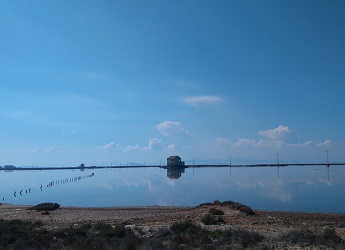
SALT FLATS OF SAN PEDRO DEL PINATAR
The Salinas de San Pedro del Pinatar form the most important wetland in the whole region. As such, they have been declared a Regional Park since 1985. Flocks of flamingos and other migratory birds nest here every year, using this natural area as a stopover on their transit between Africa and Europe.
The Salinas de San Pedro Regional Park forms a unique Mediterranean coastal area, where it is possible to see, in a small space, morphological formations such as salt flats, salt marshes, reed beds, beaches, dunes, encañizadas (a traditional fishing system of the Mar Menor by which fish entering from the Mediterranean into the lagoon are caught with a complex labyrinth of wood and reeds) and pine groves on sand. Translated with www.DeepL.com/Translator (free version)
The birdlife is particularly numerous. Although the kings, due to their spectacular appearance, are the flamingos, which arrive in flocks at the end of the summer to winter in the area, there are also grebes, plovers, herons, egrets, stilts, owls, gulls, eaglets and avocets, among other species.the presence of the salt pans is as old as the presence of man in this natural space.
They were already mentioned in documents dating back to the 14th century. The two mills that are still standing were used for years to lift water from the Mar Menor to the storage lagoons.
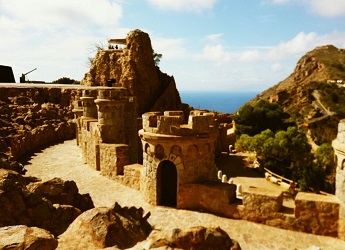
BATTERY OF CASTLES
They call it Castillitos because its entrance is like an amusement park castle, with lots of turrets and battlements, but what lies behind the mock medieval façade is impressive. Located at Cape Tiñoso, in the municipality of Cartagena, near La Azohía and 250 metres above the sea, its octogenarian cannons with their almost 18-metre tubes are impressive. The labyrinth formed by the different rooms (for each cannon, an engine room, a gunnery, a gunpowder store, a loading chamber and a spare parts store), all of them half-buried and mimicked the terrain, imitating the textures of the rock, is impressive. The views of the bay of Cartagena, the bay of Mazarrón and the abrupt Sierra de la Muela, one of the last unspoilt areas of the Spanish Mediterranean coast, are most impressive.
The battery was installed between 1933 and 1936 to defend the entrance to the Cartagena naval base. It was equipped with two 381-millimetre British guns, the most powerful and effective of the time, capable of firing a projectile weighing almost a tonne at a range of 35 kilometres. The battery was only fired once in 1937 and since then its mere presence has been enough to keep any enemy ship away. And it was refurbished to attract the curious in 2009.
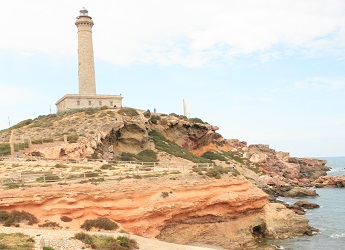
THE LIGHTHOUSE OF CABO DE PALOS
Situated on a rocky promontory, in the last foothills of the coastal mountain range of Cartagena, 80 metres above sea level, the Cabo de Palos lighthouse rises imposingly. The Special Commission on Lighthouses created it with the status of first order to dominate a wide maritime area and to direct navigations more than 20 miles around. The lack of elevation of the terrain meant that an imposing tower had to be erected so that its light would have the necessary geographical reach.
It was lit for the first time on 31 January 1865 and for almost 40 years it became the school where future aspirants to this profession were trained.
Modernisation took place in 1960 with the arrival of the electricity grid.
In front of the lighthouse, a succession of submerged reefs form a dangerous barrier to navigation that has caused numerous shipwrecks over the years. The most famous, because of its tragic and dramatic history, was the sinking of the Italian liner Sirio in 1906. The largest civil navigation accident to have occurred off the Spanish coast.
For more than 150 years the lighthouse has been the watchtower that watches over the safety of navigation in this area of the Murcian coastline. Its unique architecture has made it, deservedly, one of the most beautiful and largest lighthouses on our coasts.
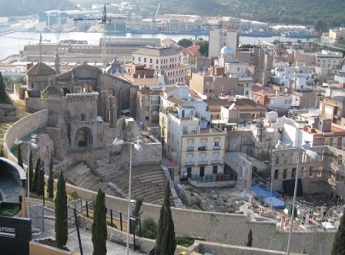
CARTAGENA
The history of Cartagena is rich, millenary and eventful, the bearer of a historical-artistic legacy, which is dotted all over the municipality, and which constitutes the greatest attraction of this port city. Cartagena is the port of a thousand cultures, an open door to the bay, from which a melting pot of civilisations, cultures and religions have penetrated, attracted by the strategic location and abundance of resources of the Cartagena territory. Translated with www.DeepL.com/Translator (free version)
This historic city was founded by the Carthaginians in 227 BC. It is also renowned for its large port, military forts and picturesque castles. It is a great Roman city, as one of its main monuments, the bullring, was built on top of the Roman amphitheatre in 1854.
The city is surrounded by 5 mountains. The Concepción Castle is a tourist attraction, as it offers some of the best views of the city from its highest point.
Nowadays it offers its history and heritage as one of its best tourist attractions.
The city is under constant renovation to satisfy each and every one of the visitor’s needs; it has numerous beautiful squares, pedestrian streets, churches, monumental buildings of great cultural and historical value, both for the inhabitants of the area and for its visitors.
The city is under constant renovation to satisfy each and every one of the visitor’s needs; it has numerous beautiful squares, pedestrian streets, churches, monumental buildings of great cultural and historical value, both for the inhabitants of the area and for its visitors.
Cartagena’s natural harbour includes a modern marina, which has been restored in recent years. There is a spectacular maritime and naval museum by the sea.
As well as being a historic city and a point of great cultural and tourist interest, it is an area designed for visitors, where you can enjoy a good gastronomic route.
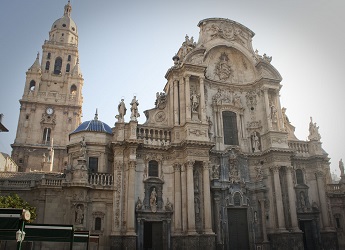
MURCIA
Situated on the banks of the Segura River, it is known by the nickname of “the Market Garden of Europe”, thanks to its fertile orchard, which exports fruit, vegetables and spices to the whole continent. This makes it a paradise for hiking enthusiasts, as its flat orchard offers a spring-like environment all year round, where you can stroll around enjoying the colours of the fruit trees and the aromas of flowers and spices. Translated with www.DeepL.com/Translator (free version)
It is also a paradise for vegetarians, as Murcian cuisine offers many original and tasty recipes based on vegetables. Among them, zarangollo, ratatouille, Murcian salad and rice with vegetables or beans stand out as typical. This does not prevent us from also finding delicious meat recipes such as the typical meat pie or venison pie.
A chain of mountains surrounds the plain on which sits Murcia, a city of Arab origin whose existence is closely linked to the fertile orchards of the Segura river. From its historic guild streets emerges the tower of the Cathedral, one of the symbols of the city.
Although the lands of Murcia have been populated for more than 2,000 years, the foundation of Murcia as a capital city was not until 831, when the Emir of Córdoba, Abderramán II, ordered the construction of a walled city on the banks of the Segura River and made it the capital of the Caliphate province. It was then that the Arabic Mursiya began to gain prominence, until it became part of the Kingdom of Castile in the 13th century.
The city is located next to the Segura river, with historic streets that have preserved the names of the guilds that used to occupy them, such as the commercial streets of Platería, Trapería and Vidrieros.
The neighbourhoods of San Pedro, Santa Catalina and the area around the Plaza de las Flores offer some of the most picturesque corners of the Murcian capital, together with its original Cathedral, located in the Plaza del Cardenal Belluga.
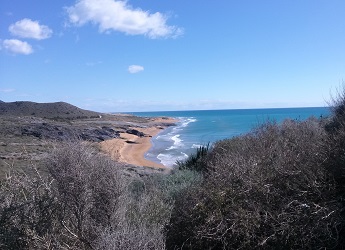
CALBLANQUE
When we talk about Murcia, the well-known Manga del Mar Menor always comes to mind, but one of the best beaches in the region is located in the Regional Park of Calblanque, Monte de las Cenizas and Peña del Águila. The protected area extends over 13 km of coastline with a surface area of 2,775.1 hectares shared by the municipalities of Cartagena and La Unión.
To enjoy these almost virgin beaches, we can get there from the motorway that goes from Cartagena to La Manga, before the campsite we will find the turn-off to the park. Once at the turn-off we continue to the visitor centre where we can obtain information about the different hiking routes available in the park.
From here we can still continue with the vehicle to a parking area located very close to the beach.
Continuing towards the beach we reach the eastern sector of the park formed by Calblanque beach, Cala Arturo, Cala Magre and Cala de los Dentoles. This is the best known area, although we must bear in mind that we are on one of the few nudist beaches in Murcia, so don’t be scared by what you see.
As is to be expected, the number of people on these beaches is lower due to the lack of knowledge of the area and the absence of any kind of population centre nearby.
As is to be expected, the number of people on these beaches is lower due to the lack of knowledge of the area and the absence of any kind of population centre nearby.
This enclave is characterised by the great diversity of environments that converge here, with Aleppo pine woods, scrubland, wadis, sandbanks, dunes, paleodunes, coves and cliffs, as well as an endorheic basin in which the Rasall salt flats are located.
contact us
Do not hesitate to contact us in any of these ways, even if you are in our area, do not hesitate to visit us.
We will be happy to help you and answer any of your questions.
CALL US
+34 968 57 21 21
hotelelmarino@yahoo.es
Privacy Policy
LOCATION
Calle Muñoz, 2. Santiago de la Ribera. Murcia
SCHEDULE
Monday-Sunday: 0.00-0.00
CALL US
+34 968 57 21 21
hotelelmarino@yahoo.es
Privacy Policy
LOCATION
Calle Muñoz, 2. Santiago de la Ribera. Murcia
SCHEDULE
Monday-Sunday: 0.00-0.00

